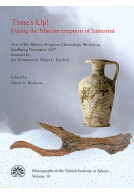Google Books previews are unavailable because you have chosen to turn off third party cookies for enhanced content. Visit our cookies page to review your cookie settings.
Ancient Harbours of the Piraeus (Hardback)
The Zea Shipsheds & Slipways 15.1 + 15.2
Imprint: Aarhus University Press
Series: Monographs of the Danish Institute at Athens
Pages: 488
ISBN: 9788771240078
Published: 31st January 2012
Script Academic & Professional
Series: Monographs of the Danish Institute at Athens
Pages: 488
ISBN: 9788771240078
Published: 31st January 2012
Script Academic & Professional
You'll be £60.00 closer to your next £10.00 credit when you purchase Ancient Harbours of the Piraeus. What's this?
+£4.99 UK Delivery or free UK delivery if order is over £40
(click here for international delivery rates)
Order within the next 3 hours, 27 minutes to get your order processed the next working day!
Need a currency converter? Check XE.com for live rates
(click here for international delivery rates)
Order within the next 3 hours, 27 minutes to get your order processed the next working day!
Need a currency converter? Check XE.com for live rates
Volume 15.1: Architecture and Topography. Volume 15.2: Finds, Area 1 Shipshed Roof Reconstructions and Feature Catalogue. Athens in the Classical period was preeminent because of her naval power. The architectural glories of the Acropolis stood in second place to her naval bases according to an unknown Athenian writer: O Athens, queen of all cities! How fair your naval base! How fair your Parthenon! How fair your Piraeus! - Com. Adespot. 340. The immense historical importance of the navy of Classical Athens is evident in her struggles against Persia ending at the Battle of Salamis, the city's central role in the First Delian League, the decades of Athens' supremacy as an imperial naval power, the victories and vicissitudes of the Peloponnesian War, and the revival and fall of the Athenian navy during the 4th century BC. With Athens navy's importance came that of her harbour city, the Piraeus, where naval bases in Zea, Mounichia and Kantharos Harbours housed hundreds of triremes that served as the primary arm of Athenian power. This first volume in the peer-reviewed Ancient Harbours of the Piraeus series is the culmination of the first phase of archaeological investigations conducted by the Zea Harbour Project, 2001-2006. The study focuses on Zea Harbour, where two previously unidentified building phases were discovered: the unroofed Phase 1 slipways, most likely belonging to the early 5th century BC, and the Phase 2 shipsheds built later in that century. This is the first solid material evidence of the naval installations dating to the zenith of Athenian military, political and cultural hegemony. In addition, shipsheds (Phase 3) that have been documented previously by W. Dörpfeld and I.C. Dragátsis (1885) are dated to 375-350 BC (terminus post quem) and architecturally redefined as double-unit shipsheds designed to house two ships stored end-to-end. Also among the principle discoveries are the establishment and measurement of the relative changes in sea level since antiquity - a key piece of the puzzle, and one that has led to a broader understanding of the topography of the ancient harbours of the Piraeus. The naval installations built in Zea Harbour in the 4th century BC were amongst the largest building complexes of antiquity and were essential for maintaining an operational fleet. In the late 330s BC, the shipsheds at Zea extended over an area of more than 55,000 m2; including the shipsheds in Kantharos and Mounichia Harbours, the total area covered by the shipshed complexes in the Piraeus was close to 110,000 m2. Hundreds of colonnades and side-walls carried the massive tiled roofs of these shipsheds, which clearly conveyed Athens' determination to 'monumentalise' and glorify the naval bases that protected the city's fleet of swift triremes at the height of her power
Other titles in the series...
Other titles in Aarhus University Press...


















